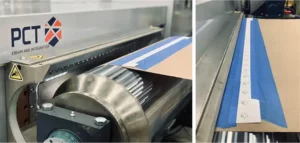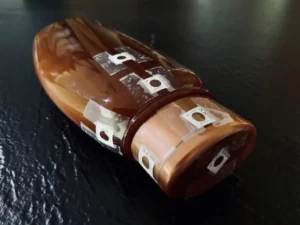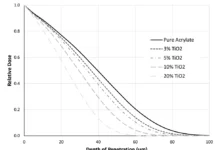Dose is a crucial variable in any electron beam (EB) application, and it is equally important to be able to measure and verify that dose. 1 Just as the output of UV lamps can be monitored by a radiometer, dosimetry can be used to monitor EB dose. From setting up a new beam to exploring new applications, during troubleshooting and after routine maintenance, dosimetry is an essential tool for ensuring optimal performance.
Dosimetry can take a variety of forms, but for surface and thin-film applications (including inks, coatings and adhesives) it is common to use dosimeters made of radiochromic film – that is, film that changes color with radiation exposure. 2,3 Examples of radiochromic dosimeters include those produced by GEX and FarWest. 4,5 The color of the dosimeter darkens with increasing dose over the viable range of the dosimeter (Figure 1). Once exposed, the dosimeter color can be set/fixed using an oven and then read using a spectrometer. The spectrometer reads the absorbance of light through the dosimeter at a single wavelength. Finally, absorbance is translated to dose using a pre-established calibration curve. 6

Electron beam manufacturers rely on dosimetry during the final stages of a beam build in a couple of different ways. First, dosimetry is used to empirically determine the k-value of the system for a given accelerating voltage. 1,2 A k-value simply is an efficiency factor that accounts for the fraction of electrons generated that are lost before reaching the product. A k-value is dependent on the machine design. Even small differences in the foil thickness or size of the air gap can impact the k-value, so for every low-energy beam
(< 300 kV), dosimetry is used to establish values at different voltages.
K-values are hidden from the everyday user, but the result of this work is that EB operators can input a dose, and the system will calculate the correct current (mA) needed for a given accelerating voltage and speed. As line speed changes, this calculation automatically updates, and the system adjusts the current to maintain a constant dose.

The second way EB manufacturers depend on dosimetry is to measure dose uniformity across the width of the beam. Maintaining good dose uniformity (typically ≤ ±10% variation) is, of course, important to maintaining good product uniformity, and thus it often is part of the acceptance criteria for a new beam. Dose uniformity easily is measured by attaching strips of dosimeters across the width of a substrate (Figure 2).
Unlike k-values, which are not often changed once established, dose uniformity has the potential to be slightly more variable. For example, although the spacing of filaments is designed so that their electron emissions overlap, if a single filament is lost, there will be a minor depression of dose in that area. For sensitive applications, when the beam warns of a filament loss, it is good practice to confirm that the dose uniformity still is within specification.
It also is good practice for all EB users to measure the dose uniformity after replacing filaments and foil. Not only does this practice provide a regular history, but there is more movement/contact involved with maintenance than during normal operation. If the cathode is not correctly aligned when replaced or a screen grid accidentally is dented, it could result in a larger dose variation across the beam width. These are not overly common errors, but it is best to suss them out, if they occurred, before production resumes.
In addition to maintenance, some EB operators use dosimeters for normal operation. This practice is more common with companies whose process requires traceability, such as when using EB for sterilization of products or for medical or pharmaceutical applications. 7,8
Unlike mercury arc UV bulbs, the output of EB filaments does not appreciably degrade over time and is steady until the filament breaks. Because of this reliability, dosimetry often is not performed routinely. However, it is recommended that operators always have a few dosimeters on hand for troubleshooting. Because the color change is very apparent, dosimeters are a quick way to eliminate the beam as the cause of an application issue, sometimes without even formally reading them.

Furthermore, dosimetry can be exceedingly helpful for application development. Dosimeters can be stacked to generate depth vs. dose curves. Similarly, they can be placed above and below a product to estimate the dose distribution through the product thickness. Dosimeters also can measure the dose distribution over the surface of complex geometries and how that distribution changes depending on its presentation to the beam (Figure 3). These types of information can be obtained using Monte Carlo simulations as well, but software for running these simulations is not always easily accessible, especially for 3D products.
Whatever the intended use, follow the instructions provided by the dosimeter manufacturer. The environment (storage and use) is important, as dosimeters are sensitive to UV, temperature, humidity and physical contaminants, such as fingerprints, inks, coatings, dirt or excessive dust. Leave dosimeters in their original packaging until needed to minimize the impact of these elements and achieve optimal results. Clean any rollers or other parts of the web path with which the dosimeters may come into contact to prevent contamination. Avoid tape in the center of the dosimeter as this will leave a residue; some dosimeters come with paper edges or a backing card for easier handling.
Ready to add dosimetry to your EB repertoire, but still have few questions? As a regular dosimetry user, your beam providers are a great resource. They will happily work with you, not only because they want your beam to run smoothly for years to come, but also because it is much easier to acquaint someone with the process when they’re not under the duress of solving a time-sensitive production issue!
References
- Schissel, S. EB Operation 101, UV+EB Technology, (1) 2021.
- Woods, R.J., Pikaev, A.K., Applied Radiation Chemistry: Radiation Processing, 1994.
- Drobny, J.G., Ionizing Radiation and Polymers: Principles, Technology, and Applications, 2012.
- https://www.gexcorp.com/b3-dosimeters.html
- https://www.fwt.com/racm/fwt60ds.htm
- Helt-Hanson, J., Miller, A., Sharpe, P., Laurell, B., Weiss, D., Pageau, G., Dµ – A new concept in industrial low-energy electron dosimetry, Rad. Phys. Chem., (79) 2010, pp 66-74.
- ISO 11137-1: 2006, Sterilization of Healthcare Products
- Trends in Radiation Sterilization of Healthcare Products, IAEA, 2008, https://www-pub.iaea.org/MTCD/Publications/PDF/Pub1313_web.pdf
 Sage Schissel, Ph.D.
Sage Schissel, Ph.D.
Applications Specialist
PCT Ebeam and Integration LLC
sage.schissel@pctebi.com






